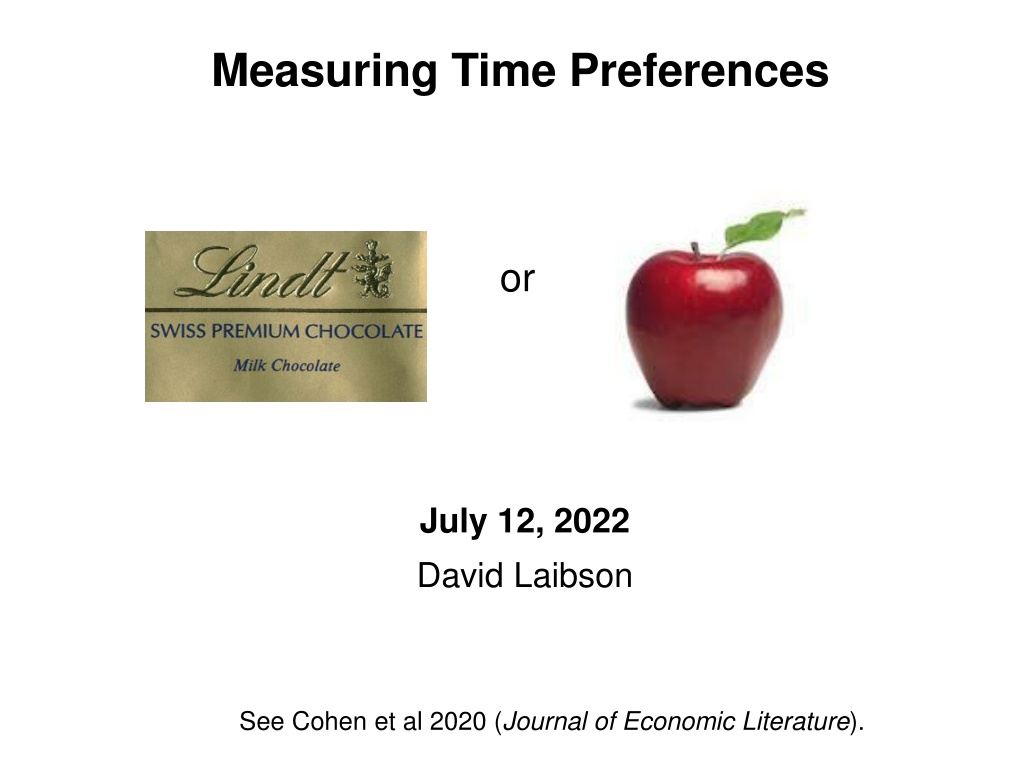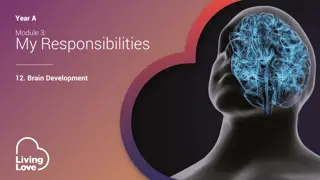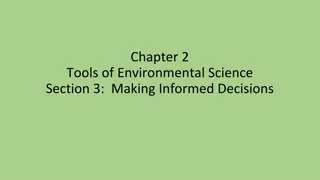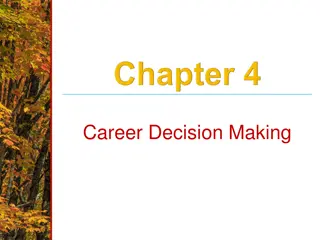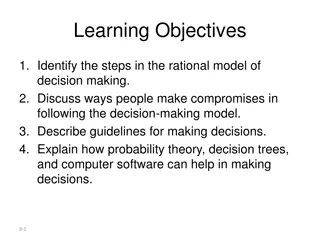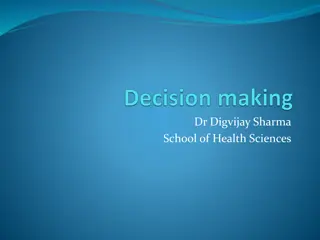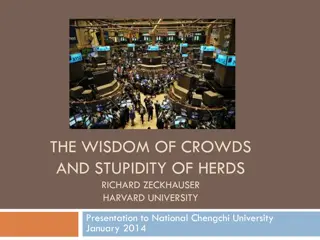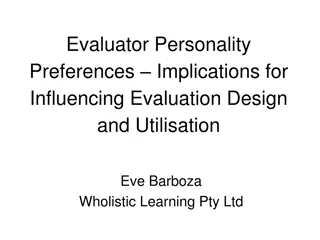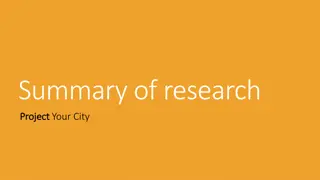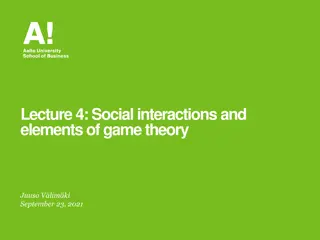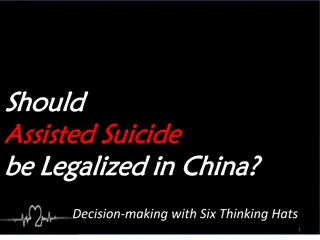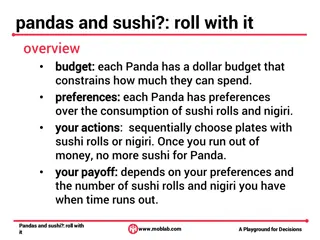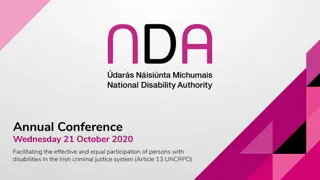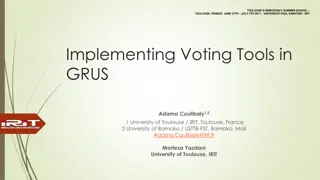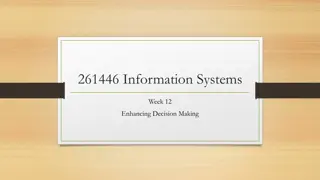Time Preferences in Decision Making
Explore the concept of time preferences through studies on preference reversals, commitment, and other types of decision-making behaviors. Discover how individuals make choices between immediate rewards and future outcomes, revealing insights into present bias and time inconsistency. Delve into research findings and real-life examples to gain a deeper understanding of how time impacts decision-making processes.
Download Presentation

Please find below an Image/Link to download the presentation.
The content on the website is provided AS IS for your information and personal use only. It may not be sold, licensed, or shared on other websites without obtaining consent from the author.If you encounter any issues during the download, it is possible that the publisher has removed the file from their server.
You are allowed to download the files provided on this website for personal or commercial use, subject to the condition that they are used lawfully. All files are the property of their respective owners.
The content on the website is provided AS IS for your information and personal use only. It may not be sold, licensed, or shared on other websites without obtaining consent from the author.
E N D
Presentation Transcript
Measuring Time Preferences or July 12, 2022 David Laibson See Cohen et al 2020 (Journal of Economic Literature).
Outline 1. Preference reversals * 2. Commitment 3. Other types of studies 4. (Structural models in future lectures) *Preferences reversals are also not sufficient to identify present bias (see Strack and Taubinsky 2021). Likewise, waiting until a deadline isn t sufficient to identify present bias (see Heidhues and Strack 2021). Need to make additional structural assumptions about the stochastic opportunity cost of time and taste shocks. 2
1. Preference reversals Quasi-hyperbolic discounters will tend to choose patiently when choosing among future periods and impatiently when choosing between the present and the future. + ( ) + 1 ( 1) D D = = Future discount rate = 1 0.05 ( ) D (0) D (1) 1 D D = = Present discount rate = 1 0.5 (0) 1 3
Read, Loewenstein & Kalyanaraman (1999) Choose among 24 movie videos Some are low brow : Four Weddings and a Funeral Some are high brow : Schindler s List Picking for tonight: 66% of subjects choose low brow. Picking for 7 days from now: 37% choose low brow. Picking for 14 days from now: 29% choose low brow. 4
Read and van Leeuwen (1998) (data from sated/sated condition) Choosing Today Eating Next Week Time If you were deciding today, would you choose fruit or chocolate for next week? 5
Patient choices for the future: Choosing Today Eating Next Week Time Today, subjects typically choose fruit for next week. 74% choose fruit 6
Impatient choices for today: Choosing and Eating Simultaneously Time If you were deciding today, would you choose fruit or chocolate for today? 7
Time Inconsistent Preferences: Choosing and Eating Simultaneously Time 70% choose chocolate 8
Percentage unhealthy snacks chosen H = hungry (late afternoon) S = sated (just after lunch) immediate immediate immediate immediate advance advance advance advance [(state when asked in advance), (state when asked immediately before consumption)]
Percentage unhealthy snacks chosen H = hungry (late afternoon) S = sated (just after lunch) immediate immediate immediate immediate advance advance advance advance [(state when asked in advance), (state when asked immediately before consumption)]
Percentage unhealthy snacks chosen H = hungry (late afternoon) S = sated (just after lunch) immediate immediate immediate immediate advance advance advance advance [(state when asked in advance), (state when asked immediately before consumption)]
See Badger et al (2007) for a related example with heroin addicts given the time- dated reward of buprenorphine ( bup ), a heroin partial agonist small sample warning (n=13) 12
Also see Sadoff, Samek, and Sprenger (2020), which uses a related experimental paradigm and a welfare-theory analysis. 13
Extremely thirsty subjects McClure, Ericson, Laibson, Loewenstein and Cohen (2007) Choosing between, juice now or 2x juice in 5 minutes 60% of subjects choose first option. Choosing between juice in 20 minutes or 2x juice in 25 minutes 30% of subjects choose first option. We estimate that the 5-minute discount rate is 50% and the long-run discount rate is 0%. Ramsey (1930s), Strotz (1950s), & Herrnstein (1960s) were the first to understand that discount rates are higher in the short run than in the long run. 15
Money now vs. money later Thaler (1981) Hypothetical payments (but many experiments use real payments) Baseline exponential discounting model: Y = tX So -ln = (1/t)ln[X/Y], where t is in units of yrs What amount makes you indifferent between $15 today and $X in 1 month (which is 1/12 years)? X = 20 -ln = (1/t)ln[X/15] = 12ln[X/15]= 345% per year What amount makes you indifferent between $15 today and $X in ten years? X = 100 -ln = (1/t)ln[X/15] = (1/10)ln[X/15]= 19% per year 19
But money earlier vs. money later (MEL) has so many confounds (Chabris, Laibson, and Schuldt 2009 Cohen, Ericson, Laibson, White, JEL 2020) Unreliability of future rewards (trust; bird in the hand; Andreoni and Sprenger 2010) Transaction costs (especially when asymmetric) Investment vs. consumption (money receipt at date t is not, necessarily a utils event at date t) Curvature of utility function (see Harrison et al for partial fixes) Framing and demand characteristics (e.g., response scale; Beauchamp et al 2020) Sub-additivity (Read, 2001; Benhabib, Bisin, and Schotter 2008) (Hypothetical rewards) Psychometric heuristics (Rubinstein 1988, 2003; Read et al 2011; White et al 2014) 20
Why are money questions unsuited to measuring discounting even in theory? If an agent is not liquidity constrained, she should maximize NPV when asked about money now vs. money later. Note that NPV is based on market interest rates, not time preferences. After maximizing NPV, she should pick her indifference point using time preferences. 21
Separation theorem: pick payment to maximize NPV, regardless of time preference (then locate along efficient frontier) Later $7 later o o '( '( ) u c u c = = Now slope MRS ) Later slope = -(1+r) o $5 now Now 22
Augenblick, Niederle, and Sprenger (2015) Three period work experiment: 0, 2, 3 At date 0: How hard do you want at work at 2 and at 3? At date 2: How hard do you want to work at 2 and at 3? At date 2, subjects tend to shift work from 2 to 3. Estimated parameters: = 0.927; = 0.997 Subjects are willing to commit at date 0 (48/80 commit). But they are generally unwilling to pay to commit. For those who commit: = 0.881; = 1.004 25
Augenblick, Niederle, and Sprenger (2015) Three period money experiment: 1, 4, 7 At date 1: How much money do you want at 4 and at 7? At date 4: How much money do you want at 4 and at 7? At date 4, subjects barely shift money to 4 from 7. Estimated parameters: = 0.974; = 0.998. 26
Augenblick, Niederle, and Sprenger (2015) Limited preference reversals in the domain of money (as predicted by the model of present bias) Present bias observed in the consumption version of the experiment. 27
Outline 1. Preference reversals 2. Commitment 3. Other evidence 28
Stickk 29 Ayres, Goldberg and Karlan: Stickk.com
Clocky 30
Tocky 31
Shreddy 32
SNUZ N LUZ 33
Freedom The granddaddy of the Internet restriction programs is Freedom. Set the $10 program and you'll be barred from surfing the net for up to eight hours at a time. Claim to have 100,000 users. Also, most of us have deleted apps from our phones or ipads at some point in our lives (and not just to clear space on our hard drive). 34
Ashraf, Karlan, and Yin (2006) Offered a commitment savings product to randomly chosen clients of a Philippine bank 28.4% take-up rate of commitment product (either date-based goal or amount-based goal) More hyperbolic subjects are more likely to take up the product After twelve months, average savings balances increased by 81% for those clients assigned to the treatment group relative to those assigned to the control group. 35
Gine, Karlan, Zinman (2009) Tested a voluntary commitment product (CARES) for smoking cessation. Smokers offered a savings account in which they deposit funds for six months, after which take urine tests for nicotine and cotinine. If they pass, money is returned; otherwise, forfeited 11% of smokers offered CARES take it up, and smokers offered CARES were 3 percentage points more likely to pass the 6-month test than the control group Effect persisted in surprise tests at 12 months. 37
Kaur, Kremer, and Mullainathan (2010): Compare two piece-rate contracts: 1. Linear piece-rate: w per unit produced 2. Linear piece-rate with penalty if worker does not achieve production target T( Commitment ) Earn w/2 for each unit produced if production < T Jump up at T, returning to baseline contract Earnings Never earn more under commitment contract May earn as much Production T 38
Kaur, Kremer, and Mullainathan (2015): Demand for Commitment: Commitment contract (Target > 0) chosen 35% of the time Effect on Production: Being offered commitment contract increases average production by 2.3% relative to control Among all participants, being offered the commitment contract is equivalent (in output effect) to a 7% increase in the piece-rate wage Participants above the mean pay-day cycle sensitivity are 49% more likely to demand commitment and their productivity increase is 9% (equivalent to a 27% increase in wage) 39
Houser, Schunk, Winter, and Xiao (2010) In a laboratory setting, 36.4% of subjects are willing to use a commitment device to prevent them from surfing the web during a work task 40
Royer, Stehr, and Sydnor (2011) Commit to go to the gym at least once every 14 calendar days (8 week commitment duration) Money at stake is choice of participant. Money donated to charity in event of failure. Fraction taking commitment contract: Full sample: 13% Gym Members: 25% Gym Non-members: 6% Average commitment = $63; max = $300, 25th pct = $20; 75th pct = $100. 41
Ariely and Wertenbroch (2002) Proofreading tasks: "Sexual identity is intrinsically impossible," says Foucault; however, according to de Selby[1], it is not so much sexual identity that is intrinsically impossible, but rather the dialectic, and some would say the satsis, of sexual identity. Thus, D'Erlette[2] holds that we have to choose between premodern dialectic theory and subcultural feminism imputing the role of the observor as poet. Evenly spaced deadlines ($20) Self-imposed deadlines ($13) subjects in this condition could self-impose costly deadlines ($1 penalty for each day of delay) and 37/51 do so. End deadline ($5) 42
Alsan, Armstrong, Beshears, Choi, del Rio, Laibson, Madrian and Marconi (2017) Voluntary Commitment Arm No Commitment Arm Get paid $30 per clinical visit, whether or not you are medically adherent. Get paid $30 per clinical visit, whether or not you are medically adherent. Get paid $30 per clinical visit, only if you are medically adherent 68% 32% small sample warning (n=40) 43
Voluntary commitment arm IC CCT No commitment arm 1.0 0.8 Proportion Suppressed 0.6 0.4 0.2 0.0 12 mo 9 mo 6 mo 3 mo V1 V2 V3 V4 V5 V6 Months Prior to Enrollment Enrollment Incentivized Visits Post- Visit Incentivized Visit
Study of rickshaw peddlers who are given access to commitment technologies Schilbach (2019) Alcohol commitment (sobriety contingent payments) Savings commitment (lockbox) 45
Commitment Technology for Alcohol Avoidance Rickshaw cyclers choose either incentive payment based on BloodAlcoholContent or unconditional payment. Incentive Payment Unconditional Payment 47
How to design a commitment contract Participants divide $$$ between: Freedom account (22% interest) Goal account (22% interest) withdrawal restriction Beshears, Choi, Harris, Laibson, Madrian, Sakong (2020)
Initial investment in goal account Freedom Account Goal Account 10% penalty 65% 35% Freedom Account Goal account 20% penalty 57% 43% Freedom Account Goal account No withdrawal 44% 56% 51
Now participant can divide their money across three accounts: (i) freedom account (ii) goal account with 10% penalty (iii) goal account with no withdrawal 49.9% allocated to freedom account 16.2% allocated to 10% penalty account 33.9% allocated to no withdrawal account Beshears, Choi, Harris, Laibson, Madrian, Sakong (2020) 52
Pre-committing to buy (crop) insurance RCT in Kenya tests (1) novel crop insurance product and (2) classical precommitment. 1) Insurance premium is deducted from farm revenues at harvest time. Take-up for pay-at-harvest insurance is 72%, compared to 5% for the standard pay-upfront contract. 2) In a related precommitment arm, enabling farmers to commit to pay the insurance premium just one month later (months before harvest) increases demand by 21 percentage points. Additional experiments and outcomes identify role of liquidity constraints and present bias. Casaburi and Willis (2018)
Outline 1. Preference reversals 2. Commitment 3. Other evidence 54
Dellavigna and Malmendier (2004, 2006) Average cost of gym membership: $75 per month Average number of visits: 4 Average cost per vist: $19 Cost of pay per visit : $10 (Also measure intentions, which exceed actual exercise) 55
Shapiro (2005) For food stamp recipients, caloric intake declines by 10-15% over the food stamp month. To be resolved with exponential discounting, requires an annual discount factor of 0.23 (147% discount rate) In other words, ln 0.23 = 1.47. Survey evidence reveals rising desperation over the course of the food stamp month, suggesting that a high elasticity of intertemporal substitution is not a likely explanation. Households with more short-run impatience (estimated from hypothetical intertemporal choices) are more likely to run out of food sometime during the month. 56
The data can reject a number of alternative hypotheses. Households that shop for food more frequently do not display a smaller decline in intake over the month, casting doubt on depreciation stories. Individuals in single-person households experience no less of a decline in caloric intake over the month than individuals in multi-person households. Survey respondents are not more likely to eat in another person s home toward the end of the month. The data show no evidence of learning over time 57
Social security Mastrobuoni and Weinberg (2009) Individuals with substantial savings smooth consumption over the monthly pay cycle Individuals without savings consume 25 percent fewer calories the week before they receive checks relative to the week afterwards 58
